Immediate aside: Could I possibly come up with a broader question to start a discussion? Let me hone in a little more.
The idea for this post came out of a Armchair Director Forum member's mention of the use of symbolism in Children of Men. He was trying to sort out what particular images in the movie meant symbolically: premonitions of death (Clive Owen looking through a dirty and broken window at the pregnant girl outside) or easy aphorisms like life is fleeting (the appearance of the deer inside the school). Reading this, I guess, I had a negative reaction at first. How is it that we can say anything for sure about these images?
But hmm....I guess one would probably say that digging up and polishing symbolism in a film is one part of the analysis of that film. And in doing analysis, we need to try on all sorts of clothes to see which ones fit. However, I think trying to give a definite meaning to a given image or sequence can be a red herring as well. How do we know what Cuaron meant with the deer in the school? How do we know that Cuaron had something particular in mind? It is well known that scholars and admirers of Tarkovsky's films make a lot out of his use of rain in his films, yet when pressed to say what the rain means to him, Tarkovsky said something to the effect of, "It's just rain."
Of course, then one will say, well, it doesn't matter what Tarkovsky thinks because once he puts his work out there, he is no longer the authority on what his work means. Point conceded. The viewer should be an equal participant in the ongoing discussion after the filmmaker moves to start the conversation (nod to Brian Park for the idea).
But this goes on to another question: what is the most effective use of symbolism? I would argue that if I can tell that the film is trying to convey a symbol, then the film has failed in making that symbol in any way meaningful to me. I feel cheated if I notice the deer means anything other than a deer. I think this is partly what Tarkovsky is trying to get at. The scholars dice up his films to find some way to describe their primal power, but for Tarkovsky, he is filming what is natural to him. He grew up in an area of Russia where it rained a lot, apparently, so that it would rain in his films is not surprising. And anyway, the symbol's effectiveness (hiddenness) hinges on our being sucked into the film we are watching, so if we are trying to figure out the code during our viewing, we are going to get less out of the symbolism and less out of the film. So in that sense, of course Tarkovsky is going to mask his intentions (if he has any). Besides, analysis is such a personal endeavor that for a director to say, "This means that," would be both unfair to those that would take the interpretation as law, and untrue, as in, there is never going to be one meaning to a symbol and the best symbols are those that are too complex to root out anyway.
That last sentence sounds a bit simplistic in some weird way, I'm not sure. Let me explain further. I think the best expressions of cinema are those that are unexplainable. I cannot explain why the Jaguar Shark sequence is so powerful at the end of Life Aquatic . I cannot explain to you how wonderful Tarkovsky's still life set-ups are throughout his films. We're not sure why we feel the way we do, and to try to describe those feelings would be silly. This only means that in these instances, we grant that cinema has come up with its own language, one that is purely cinematic, that is not held captive by literary analysis. If it is possible to come up with some different model by which we might describe cinematic language, I'm not sure. I'm also not well-educated enough with film theory to have a grasp on whether this has already been done well (I'm sure many attempts have been made).
I might stand behind a conjecture though: pure cinema taps into our deepest expressions of self, communal and spiritual awareness, and that we will never know exactly how that works (simply because, we did not make ourselves).
Wednesday, January 24, 2007
Thursday, January 11, 2007
Grey Gardens - Maysles Brothers (1976)
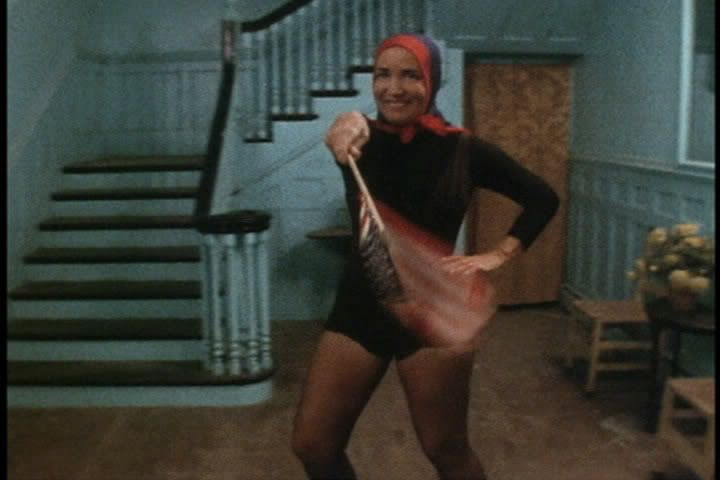
A documentary of particular note, Grey Gardens.
An old lady and her daughter (relatives of Jackie Kennedy Onassis) live alone in a huge, untended East Hampton house, eating ice cream and remembering the past. There is a passion and eccentricity that fill both of these women, and they fill this empty house. At times, the house seems too small for the both of them! Big Edie was an incredible singer, making records when she was younger, and also a mother of three (or four, I can't remember). Little Edie was a bombshell, a dancer and model, who rejected the men that got past her mother. Talking, always talking the both of them, and at the same time. Putting each other down, arguing about minor details from the past. Big Edie roosts in her bed as if it were a throne, cooking or looking at black-and-white photos, and always a word for her daughter. But she does it in such an unorthodox way, obsessively adjusting the brim of a floppy hat, peering through her bent glasses, that she comes off as a harmless old lady. We know that she has a hold on her daughter though: she has kept her daughter by her side for the majority of her daughter's adult life.
It is Little Edie that intrigues me the most. She says over and over how much she wants to get out of the house, out of the Grey Gardens as they call it. But Little Edie is 56 years old, and has been living with her mother for almost 25 years. She wears costumes and dances around the house as if she were constantly putting on a show. Edie reminds me of a movie star of old, glamorous and dramatic in her own way (she's fond of skirts and stockings). Sometimes in the monologues Edie delivers, she has the sensibility of a teenager, nitpicking and gossiping. But other times, she philosophizes as if she were the only person in the world at that moment. I believe that even if the cameras weren't there, she would still dance and talk to herself.
There are cats and raccoons everywhere in the delapidated house. The gardens themselves are overgrown, and from the balcony of the estate, where the two sunbathe, you could walk across the tops of the trees to the ocean.
There is no narrator here, there are only the two women talking. Once in a while one of the Maysles, holding camera and sound equipment show up in the film, pointing the camera at a mirror or taking an offered snack. But this is Little and Big Edies' show. There are all sorts of beautiful moments in this superb example of cinema verite. More people will be able to see it now that it's recently come out on Criterion. And you should see it too.
Monday, January 8, 2007
Barry Lyndon - Stanley Kubrick (1975)
Trying to pick a single screenshot out of this movie is on the level of what it was like trying to pick a single piece of candy out of a gigantic candy store when you were a kid, and your mommy said, only one piece, only one. I simply can't pick a single one out, so we'll have several. My pointer finger was poised on the screen capture button of my computer's DVD player during the entirety of this film. Counting up the total, I landed on a rather round number, 100 screen shots. Imagine that. This is one of the most beautiful films ever made, and even though it is not obscure by any means, I can't help but badger those who haven't seen it yet. Give it a shot. Yes, it's 3 hours long, yes, the main character has a limited emotional range and is hard to identify with, yes, the story is rather straight forward. It is the story of one man's rise and fall in a time long past. I still recommend it. Let me try to explain why.
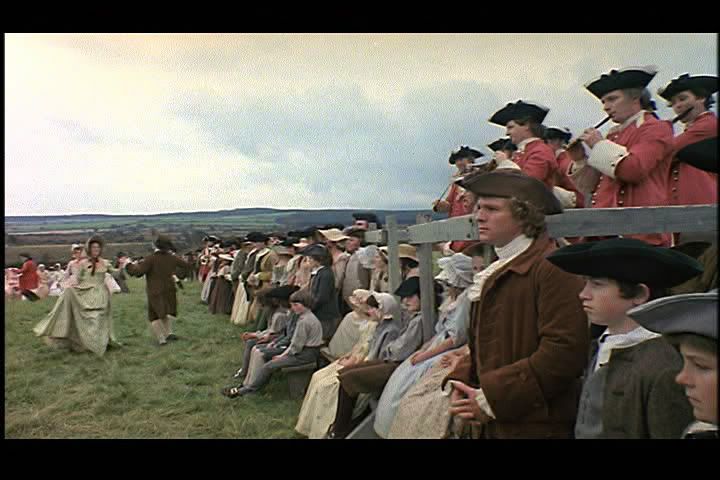
Here's our man. The one in the brown on the right with the blank look on his face. Yep, that's him. Redmond Barry/Barry Lyndon (played by Ryan O'Neil) is his name, and I would argue that he is a stand-in for all of us. This is quite a task, to be an everyman. The narrator and the characters in the story help to create the Barry persona by constantly pegging him as an upstart, a simpleton, a rogue. Everyone who meets Barry seems to have a distinct opinion of him. In this way, Kubrick sets up Barry as the everyman. But we look deeper and we see that our everyman is incredibly human, more complex than anyone gives him credit for. A case in point is Barry's relationship to the various father-figures that cross his path in life. Barry's emotional reliance on both the Captain Grogan and the Chevalier gives us a deeper look into a man who lives in a time where emotion is not expressed, where love and meaningful relationships are cast aside in the name of advancement and financial survival. Barry is not a saintly everyman. He is a sinner, a shameful one at times, but this adds to a fuller picture of our main character. No we don't identify with either Redmond Barry or Barry Lyndon, but we are given a well-drawn, fully-human character to stand-in for us in this time long past (to which we have no real connection otherwise).
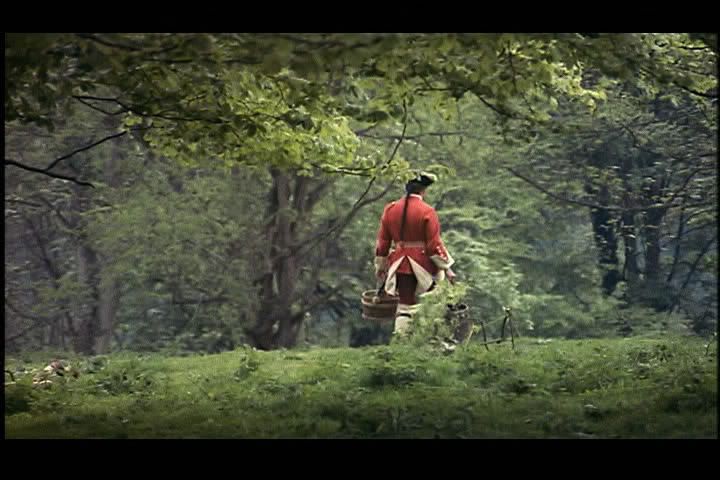
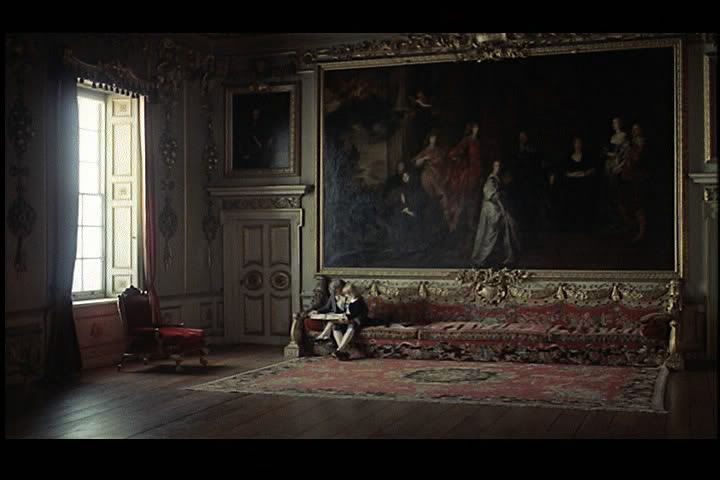
God, how small we are. How small we are in this beautiful world. This is what I think of when I watch Barry Lyndon. Whether indoors or outdoors, Kubrick frames his characters in such a way as to put them in their place with respect to their surroundings, not unlike the classical Japanese painters of old. Trees, castles, paintings tower over Barry and the other characters of this world. Huge, sweeping events, such as the Seven Years War, and socio-political struggles, a result of the wide chasm between the nobility and the peasantry, rage on around Barry, showing him no particular deference (as the main character of the story). The narrator seems to regard humanity's value in free will with some humor as he describes Barry's journey through life as a mash of good and bad luck. But even if we agree with the narrator, we look beyond the fate-driven thrust of Barry's life and we see more than one life, but a multitude of lives dwarfed by the beauty of things that will outlast them. Having moved beyond the main narrative, we see the beauty of nature and even the beauty of things humanly-created.
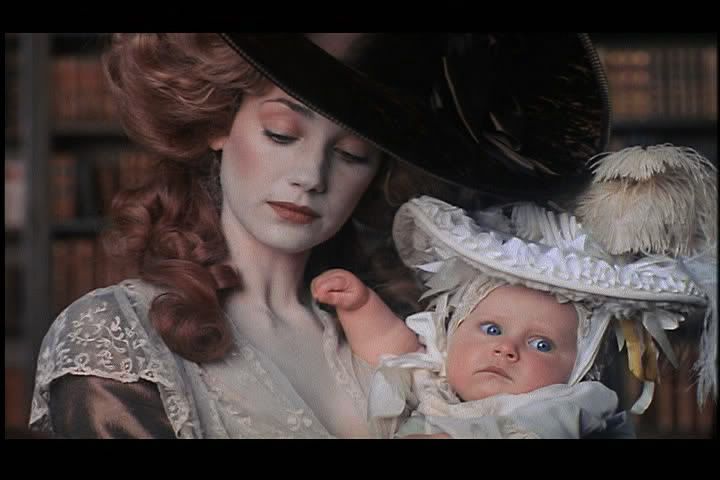

Then, we notice smaller things in the film, such as the intense, sideways glance of a baby. We notice the contrast between the sheen of a tossed coin and the dirt and hay of the ground, in the midst of a duel between main characters. We notice the birds chirping, and the wind that blows hard through the Irish farmlands, elements of nature expressing emotion when our characters cannot. We wait expectantly for the long, calculated zoom-outs, revealing more and more of the lush surroundings, and having gotten there, we revel in the close-ups of faces, drawn tight and impassionate, revealing nothing.
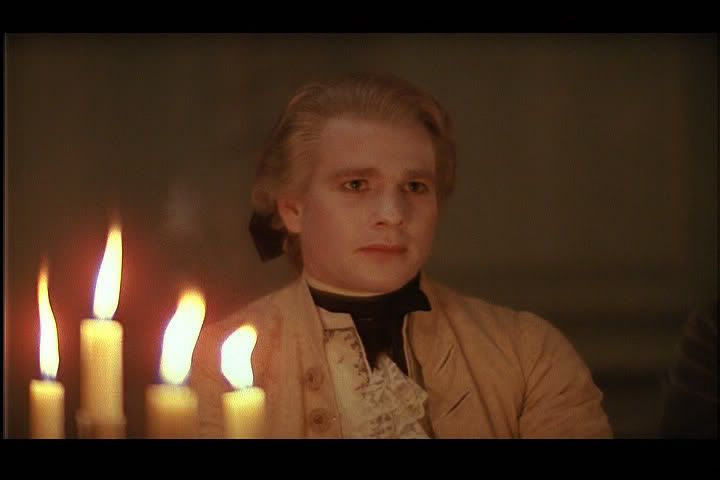
But then sometimes, we notice that there is something more behind these blank stares, and Kubrick shows us how love happens and how grief happens in the midst of these greater, eternal forces. When Barry and the Countess of Lyndon's lock gazes, Kubrick fans the flames by jumping back and forth between the same two shots of connection between them. Candles flicker in the lower left hand screen of both shots. Then there is the scene at the end when the Countess stares at a note she is about to sign (I won't say more than that) and she stares off into space for a moment, remembering all that has passed.
Even in the midst of these larger forces, we have people. But most of all, we have an incredibly poetic film, perhaps the greatest period piece ever made, and one of Kubrick's best.

Here's our man. The one in the brown on the right with the blank look on his face. Yep, that's him. Redmond Barry/Barry Lyndon (played by Ryan O'Neil) is his name, and I would argue that he is a stand-in for all of us. This is quite a task, to be an everyman. The narrator and the characters in the story help to create the Barry persona by constantly pegging him as an upstart, a simpleton, a rogue. Everyone who meets Barry seems to have a distinct opinion of him. In this way, Kubrick sets up Barry as the everyman. But we look deeper and we see that our everyman is incredibly human, more complex than anyone gives him credit for. A case in point is Barry's relationship to the various father-figures that cross his path in life. Barry's emotional reliance on both the Captain Grogan and the Chevalier gives us a deeper look into a man who lives in a time where emotion is not expressed, where love and meaningful relationships are cast aside in the name of advancement and financial survival. Barry is not a saintly everyman. He is a sinner, a shameful one at times, but this adds to a fuller picture of our main character. No we don't identify with either Redmond Barry or Barry Lyndon, but we are given a well-drawn, fully-human character to stand-in for us in this time long past (to which we have no real connection otherwise).


God, how small we are. How small we are in this beautiful world. This is what I think of when I watch Barry Lyndon. Whether indoors or outdoors, Kubrick frames his characters in such a way as to put them in their place with respect to their surroundings, not unlike the classical Japanese painters of old. Trees, castles, paintings tower over Barry and the other characters of this world. Huge, sweeping events, such as the Seven Years War, and socio-political struggles, a result of the wide chasm between the nobility and the peasantry, rage on around Barry, showing him no particular deference (as the main character of the story). The narrator seems to regard humanity's value in free will with some humor as he describes Barry's journey through life as a mash of good and bad luck. But even if we agree with the narrator, we look beyond the fate-driven thrust of Barry's life and we see more than one life, but a multitude of lives dwarfed by the beauty of things that will outlast them. Having moved beyond the main narrative, we see the beauty of nature and even the beauty of things humanly-created.


Then, we notice smaller things in the film, such as the intense, sideways glance of a baby. We notice the contrast between the sheen of a tossed coin and the dirt and hay of the ground, in the midst of a duel between main characters. We notice the birds chirping, and the wind that blows hard through the Irish farmlands, elements of nature expressing emotion when our characters cannot. We wait expectantly for the long, calculated zoom-outs, revealing more and more of the lush surroundings, and having gotten there, we revel in the close-ups of faces, drawn tight and impassionate, revealing nothing.

But then sometimes, we notice that there is something more behind these blank stares, and Kubrick shows us how love happens and how grief happens in the midst of these greater, eternal forces. When Barry and the Countess of Lyndon's lock gazes, Kubrick fans the flames by jumping back and forth between the same two shots of connection between them. Candles flicker in the lower left hand screen of both shots. Then there is the scene at the end when the Countess stares at a note she is about to sign (I won't say more than that) and she stares off into space for a moment, remembering all that has passed.
Even in the midst of these larger forces, we have people. But most of all, we have an incredibly poetic film, perhaps the greatest period piece ever made, and one of Kubrick's best.
Saturday, January 6, 2007
The Discreet Charm of the Bourgeoisie - Luis Bunuel (1972)

This is a strange film. Know that first and foremost. And I imagine that people like it for very different reasons. You may like the marvelous acting of the six bourgeois, who try for the entire film to have an uninterrupted dinner (as in the picture above when a cavalry unit preparing for maneuvers stops by for a meal). You may like the surrealist twists and turns, as much of the latter half of the film is made up of dreams and nightmares. You may like the vibrant use of color, which is subtly employed so as to show a manner of restraint (Bunuel seems to accentuate the color of a particular outline or object sporadically through the film). You may even like the socio-political statement that Bunuel is making, Marxist in tone at times, and always taking jabs at the upper class.
I can't say that I resonate with these reasons though. In fact, if it wasn't for two particular sequences in the film, I wouldn't have a personal reason to recommend the film. The two sequences I speak of are the Lieutenant's tale of his childhood and the Sergeant's dream, which start out as stories told by minor characters to the main character listeners, but become something much more as the viewer is transported into the story. In both instances, the sequences take the viewer completely outside of the world of the six bourgeois, both in terms of narrative and in terms of tone. Of course, the power of these sequences probably comes with the juxtaposition they make to the rest of the film, so I cannot claim to like the film just for these sequences. But let me try to explain a little further...
In the midst of Bunuel's biting satire, we are treated to these two sequences of somber beauty, drawing upon the memories and longings of the storyteller. In the Sergeant's dream for example, we find him walking down the street, his eyes downcast, the buildings along the way appearing as part of a set (the doors and windows have been painted on). A church bell tolls throughout the sequence, as well as the chattering of people we cannot see. He meets a man who "smells of earth," who after brief conversation, quickly disappears into an open doorway to "buy something." A conversation with another man, who helps the Sergeant realize that he is in the land of the dead. Outside, a girl of deathly white, the Sergeant's mother, who he did not know well when she was alive. Two incredible opposing images of the two talking, the mother unable to meet her son's gaze. She says, "I looked for you in this dark crowd, I've been looking since I arrived." A cut to her grave, hands draped over a crucifix, as the first shovels of dirt cover her plain dress. The Sergeant goes looking for the first man in the building in order to introduce the man to his mother. Inside, a stairway covered in cobwebs and dirt. The Sergeant calls for the man, but there is no answer. Outside, time has passed, and the Sergeant is alone. No mother, alone.
And then Bunuel takes us back to the world of the bourgeois and the moment passes as if it was nothing. But it is the reason I recommend this film to you. The fact that we are so detached from the rest of the film makes these sequences that much more powerful. The two sequences are transcendent moments, emotional blips in a film about social etiquette and superficiality. As I mentioned, the film has other dream sequences, mostly from the minds of the six bourgeois, but they do not compare to the two mentioned above. The six are wholly consumed by their insecurities and appearances. The Sergeant and Lieutenant long for that which is beyond themselves, and we long with them.
Thursday, January 4, 2007
Hiroshima, Mon Amour - Alain Resnais (1959)
I don't know where to start with this film, so I'll go with the score. Very moving. Hypnotic film, and the score always seems to complement perfectly the images on screen. Although not as pointed in its use of "music as punctuation" as say, In the Mood For Love, still similar in effect.
The visuals are dazzling, so I need to include one or two as a point of reference, before moving on. The meat of this entry starts here:

The opening scene has the couple wrapped up in a human knot of arms and sweaty backs, and we only hear the voice of Emmanuelle Riva, as she recounts an experience with Hiroshima. We wonder, is it her experience? Is it his? The film is notable for its interplay between the now and the past, for its mingling of identities. Here in the picture, the two have become untangled for a moment.

Here is an image from one of the most beautiful sequences in the movie. The two continue to hash out their stories, and while they do it, Emmanuelle Riva is chugging beer as if it were some sort of life-potion. Behind them, the lights of the city glance off the water, creating a shimmering display through the restaurant window. Of course, they are too wrapped up in each other to notice it, but we do.
Throughout the film, actually, I was reminded of a pair of films we've talked about recently, Before Sunrise and Before Sunset. Two strangers of different nationalities meeting and having this moment together, intense and cathartic. Celine and Jesse will have two moments, this couple will only have one. In Hiroshima, Mon Amour, the difference in nationality plays out more, as the two talk about their experiences in the war. Riva fell in love with a German soldier and upon discovery, was ostracized by her own parents, and locked in a cellar. Eiji Okada lost his family in Hiroshima while off fighting. The two talk to each other not just in romantic terms, but in terms of filling these holes from the past. When Riva and Okada make love, they are making love in the empty spaces of these holes, the rifts between nations and between persons torn apart by war. And they are also making love TO the holes, to the pain and suffering they have experienced and cannot separate themselves from. It is a painful thing to watch, but it is beautiful as well. Beauty contained within the ugliness. That's how I would describe Hiroshima, Mon Amour.
The visuals are dazzling, so I need to include one or two as a point of reference, before moving on. The meat of this entry starts here:

The opening scene has the couple wrapped up in a human knot of arms and sweaty backs, and we only hear the voice of Emmanuelle Riva, as she recounts an experience with Hiroshima. We wonder, is it her experience? Is it his? The film is notable for its interplay between the now and the past, for its mingling of identities. Here in the picture, the two have become untangled for a moment.

Here is an image from one of the most beautiful sequences in the movie. The two continue to hash out their stories, and while they do it, Emmanuelle Riva is chugging beer as if it were some sort of life-potion. Behind them, the lights of the city glance off the water, creating a shimmering display through the restaurant window. Of course, they are too wrapped up in each other to notice it, but we do.
Throughout the film, actually, I was reminded of a pair of films we've talked about recently, Before Sunrise and Before Sunset. Two strangers of different nationalities meeting and having this moment together, intense and cathartic. Celine and Jesse will have two moments, this couple will only have one. In Hiroshima, Mon Amour, the difference in nationality plays out more, as the two talk about their experiences in the war. Riva fell in love with a German soldier and upon discovery, was ostracized by her own parents, and locked in a cellar. Eiji Okada lost his family in Hiroshima while off fighting. The two talk to each other not just in romantic terms, but in terms of filling these holes from the past. When Riva and Okada make love, they are making love in the empty spaces of these holes, the rifts between nations and between persons torn apart by war. And they are also making love TO the holes, to the pain and suffering they have experienced and cannot separate themselves from. It is a painful thing to watch, but it is beautiful as well. Beauty contained within the ugliness. That's how I would describe Hiroshima, Mon Amour.
Subscribe to:
Posts (Atom)